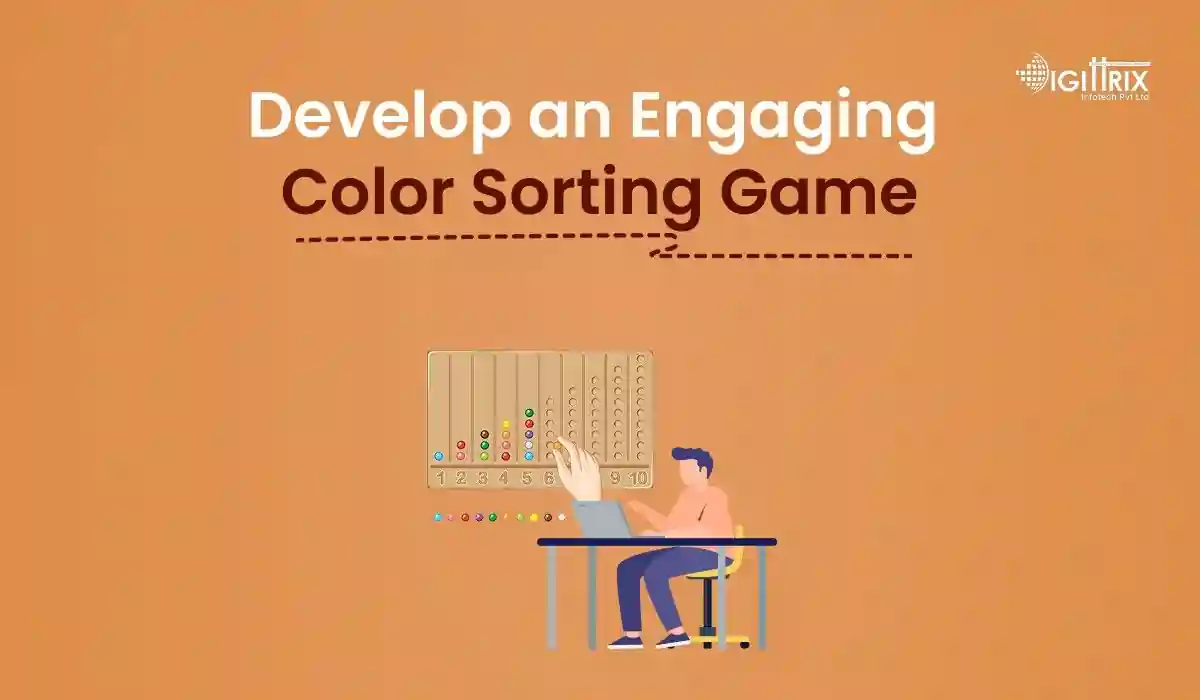In 2023, global mobile game revenue stabilized at $76.7 billion, 22% above pre-pandemic levels with projections indicating a rebound in 2024.
Highlights
An enthusiastic developer and skilled business management expert with over a decade of experience in the field

Color sorting games have gained popularity for being simple yet highly addictive. These puzzle-based games challenge users to sort colored items into groups or containers based on color. Whether you’ve played games like “Sort It 3D” or “Water Sort Puzzle,” you already know how satisfying it is to solve each level. If you're planning to create one, this guide will help you through every stage of color sorting game development — from concept to final release.
Whether you are an individual developer or part of a mobile app development company, this article gives a detailed breakdown of how to design, build, and publish a color sorting game that people will want to play again and again.
Want to reach global users? Check Digittrix's take on app localization and how it fuels business growth!
Before writing a single line of code, it’s important to define the idea behind your game. A color sorting game usually involves sorting colored items (like balls, tubes of liquid, or blocks) into matching groups. The game mechanics are based on logic and pattern recognition, making it suitable for all age groups.
Start by identifying the platform. Will you focus on Android game development, iOS, or both? If you’re a beginner, developing for Android might be a good first step due to its open ecosystem. Games Industry report shows that mobile game revenue is projected to reach $116 billion in 2024.
Look at the most downloaded color sorting games on the App Store and Google Play. Study their gameplay, level designs, UI, and reviews. Note what users love and what they complain about. This will help you understand what works and what doesn't.
Also, check how many levels they offer, how animations behave, how scoring systems work, and how monetization is implemented.
This research is not about copying others but learning what kind of experiences users expect from this type of game.
Once you have the game idea and reference points, it’s time to choose your development tools. For game app development, some popular options include:
You will also need a graphic design tool like Adobe Illustrator or Figma to create your game’s visual elements.
Choose a tool based on your budget, technical skill, and platform choice. If you're hiring game app developers, confirm which tools they are comfortable using.
Here, you’ll outline how the game will work in detail.
Keep it clean and intuitive. Use easy-to-read buttons, soft backgrounds, and appealing color schemes that match the nature of the game.
Game Progression:
Design a level system that gradually increases in difficulty. You can start with 3-4 colors and slowly go up to 8 or 10 as the player progresses.
Create Game Art and Sound
Visual and audio elements play a big role in keeping users interested.
Use vector-based graphics for scalability and quality. Create items that are easily distinguishable in color and shape. Your UI should be simple enough for a 6-year-old but also satisfying for older players.
Add light background music and short sound effects when players move items, complete a level, or make an error. Avoid sounds that are too loud or repetitive.
Animations can also add to the user experience. A small splash effect when a player makes a correct move adds satisfaction without being distracting.
With your assets ready, it’s time to start building. This step involves writing the logic that powers the game.
If you are doing mobile game development using Unity, you’ll likely use C#. Begin by setting up the containers and colored items. You’ll need to create:
If this is your first time coding a game, try starting with a basic prototype with just 2 or 3 colors and expanding as you go.
A scoring system isn’t always necessary in a color sorting game, but it can make it more engaging. You can add points based on time taken, number of moves, or consecutive wins.
Adding a few free hints per day helps players who get stuck. You can also offer hints through ads or in-app purchases, a standard monetization method in on-demand app development. According to Sensor Tower, casual mobile games significantly contributed to 2023's revenue growth.
Before releasing your game, conduct thorough testing. Check for:
Use both manual and automated testing tools. Ask friends or colleagues to play the game and give feedback. Note areas where they get confused or lose interest.
Pay special attention to how the game behaves on different screen sizes and Android versions, especially if your focus is on Android game development.
If you want to make money from your color sorting game app, consider these methods:
Be sure to balance monetization so it doesn’t frustrate users. Too many ads or expensive items can cause users to uninstall the game.
Once you’ve built and tested your game, it’s time to publish it on the app stores.
For Google Play:
For Apple App Store:
The process is stricter. You’ll need a Mac to compile your game for iOS and go through Apple’s review process.
A good mobile game development team can help with this entire phase if you don’t want to manage it alone.
Once your game is live, promotion is key. You can:
App store optimization (ASO) is also important. Use relevant keywords like Color Sorting Game App in your app title and description to increase visibility. Sensor Tower information shows U.S. mobile game revenue is expected to hit $33.5 billion by 2028.
After launch, your job isn’t done. Read user reviews and collect in-game analytics. Pay attention to which levels users find too hard, how long they play, and what features they request.
Regularly update the game to fix bugs and add new levels or features. This helps keep your users active and brings new ones in.
Working with a good game app development company can help maintain quality and fix issues quickly.
Color sorting games are easy to pick up and play, but they require a good balance of design, logic, and polish. Whether you’re an individual creator or part of a team offering game app development, the goal is to build something fun, challenging, and visually appealing.
If you’re serious about entering the gaming market, hiring experienced game app developers can save time and avoid mistakes. Choose a partner who understands not just the technical side, but also the fun part of game design.
Color Sorting Game Development is a great starting point for beginners and indie studios looking to build games that users love to return to. With clear planning, solid tools, and consistent updates, your game can find its audience and grow steadily over time.
The demand for Color Sorting Game App development is rising as users enjoy simple yet challenging gameplay that sharpens focus and decision-making. Businesses investing in color sorting puzzle games in 2025 can tap into a wide user base by offering attractive visuals, intuitive controls, and rewarding mechanics.
If you're planning to build a color sorting game, working with an experienced mobile game development company is crucial. At Digittrix, we offer complete game app development services—from concept to deployment—ensuring smooth performance, scalable architecture, and monetization features. Whether you're inspired by popular color puzzle games or have a custom idea, our skilled game app developers can bring your concept to life with creativity and precision.
Curious about Color Sorting Game Development or want to discuss the cost of building your puzzle game app? Contact Digittrix at +91 8727000867 or email digittrix@gmail.com for a detailed consultation.

Do you need help in Mobile App development?




Join over 1500+ businesses we've already helped!
Beauty App Development: Tips to Grow Your Business Through an App & Cost in India (2026)
A color sorting game is a logic puzzle where players sort colored items into separate containers. The goal is to group similar colors using the fewest moves.
Unity is a popular choice for game app development due to its cross-platform support, asset store, and large developer community.
Yes. You can earn through ads, in-app purchases, or paid versions. Just be careful not to interrupt gameplay too often with ads.

©2026Digittrix Infotech Private Limited , All rights reserved.